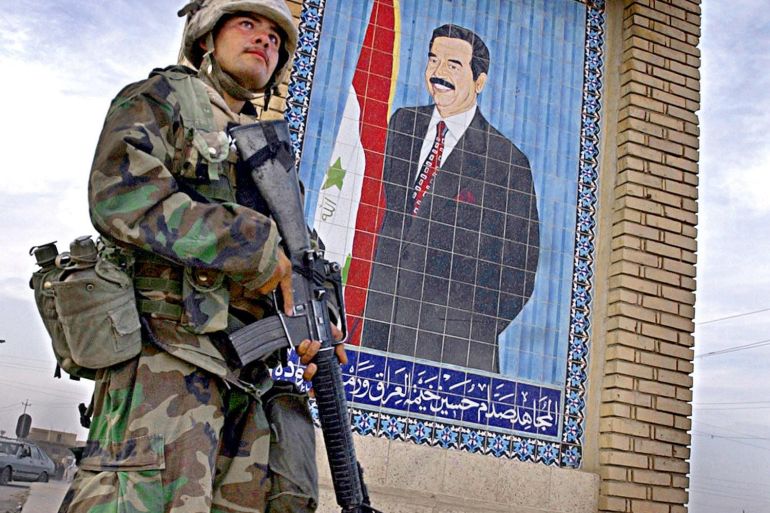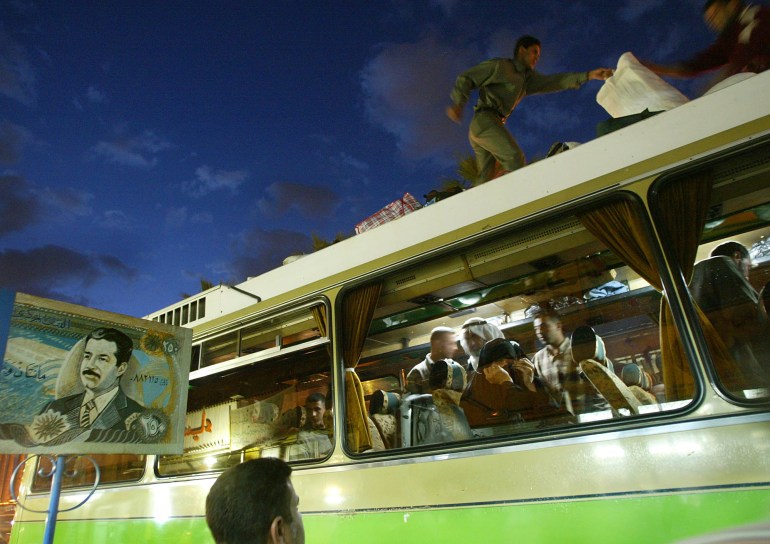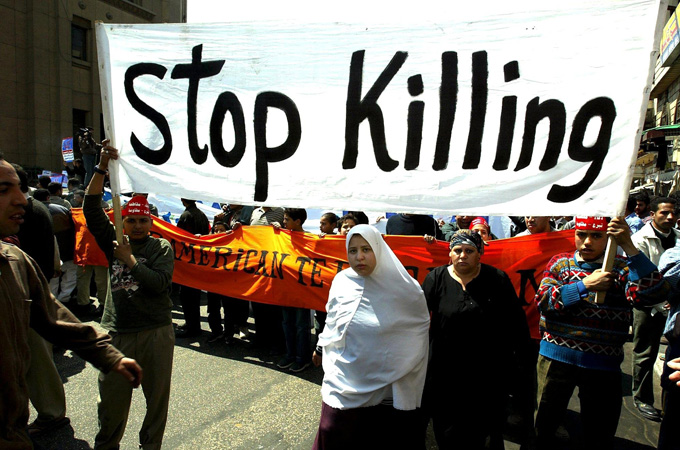How the US and UK tried to justify the invasion of Iraq
What were the reasons given for the Iraq war, and how do they stand up today?

On March 20, 2003, the United States led a coalition that launched a fully-fledged invasion of Iraq, closely supported by the United Kingdom.
The case it had made for invading the Middle Eastern nation was built on three basic premises: that the regime of Saddam Hussein had weapons of mass destruction (WMD); that it was developing more of them to the potential advantage of “terrorist” groups; and that creating a “friendly and democratic” Iraq would set an example for the region.

However, 20 years after the launch of Operation Iraqi Freedom, the question of whether the invasion of Iraq was the product of the wilful deception of US, UK and other voters, wrongful intelligence or a strategic calculus is still a matter of debate.
What appears inescapable is that the Iraq war has cast a long shadow over the US’s foreign policies, with repercussions to this day.
Keep reading
list of 3 itemsPentagon chief, on surprise trip, says US troops to stay in Iraq
Iraqis still haunted by Saddam-era disappearances after his fall
Weapons of mass destruction
“Let me begin by saying, we were almost all wrong, and I certainly include myself here,” David Kay, head of the Iraq Survey Group (ISG), told the US Senate on January 29, 2004.
His team – a fact-finding mission set up by the multinational force to find and disable Iraq’s purported WMDs – was ultimately unable to find substantial evidence that Hussein had an active weapons development programme.
The Bush administration had presented that as a certainty before the invasion.

In a speech in Cincinnati in the US state of Ohio on October 7, 2002, the US president declared that Iraq “possesses and produces chemical and biological weapons. It is seeking nuclear weapons.”
He then concluded that Hussein had to be stopped. “The Iraqi dictator must not be permitted to threaten America and the world with horrible poisons and diseases and gases and atomic weapons,” Bush said.
Then-British Prime Minister Tony Blair had said the same thing on September 24, 2002, as he presented a British intelligence dossier affirming that Hussein could activate chemical and biological weapons “within 45 minutes, including against his own Shia population”.
When the ISG presented its findings, one of the war’s main arguments crumbled. “We’ve got evidence that they certainly could have produced small amounts [of WMD], but we’ve not discovered evidence of the stockpiles,” Kay said in his testimony.
According to Sanam Vakil, deputy director of the Middle East North Africa programme at Chatham House, the decision to invade Iraq was a “huge violation of international law” and that the real objective of the Bush administration was a broader transformational effect in the region.
“We know that the intelligence was manufactured and that [Hussein] didn’t have the weapons,” Vakil told Al Jazeera.

“They felt that by overthrowing Saddam Hussein and supposedly bringing democracy to Iraq then there would be a domino effect,” Vakil said.
Some observers have pointed to the fact that while the ISG did not find an active WMD program, it had gathered evidence that Hussein was planning to resume the programme as soon as international sanctions against Iraq were lifted.
According to Melvyn Leffler, author of the book, Confronting Saddam Hussein, uncertainty was a defining factor in the months prior to the invasion.
“There was an overwhelming sense of threat,” Leffler told Al Jazeera. “The intelligence community in the days and weeks after 9/11 developed what they called a ‘threat matrix’, a daily list of all incoming threats. This list of threats was presented to the president every single day.”
Hussein himself had led many to believe that Iraq’s WMD programme was active. In an interview by US interrogators compiling the report into the country’s WMDs in 2004, he admitted to having been wilfully ambiguous over whether the country still retained biological agents in a bid to deter longtime foe, Iran.
For years prior to the invasion, Hussein resisted inspections by the United Nations Monitoring, Verification and Inspection Commission, established in 1999 with the mandate to disarm Iraq of its WMDs.

‘Terrorism’
While Bush campaigned for the presidency on the promise of a “humble” foreign policy, the attack on the World Trade Center on September 11, 2001, dragged the US on a decades-long global counterterrorism military campaign it dubbed the “War on Terror”.
In his State of the Union address on January 29, 2002, Bush stated in no uncertain terms that the US would combat “terrorist groups” or any country deemed to be training, equipping or supporting “terrorism”.
“States like these, and their terrorist allies, constitute an axis of evil, aiming to threaten the peace of the world,” he said.
The speech went on to identify Iraq as a pillar in the so-called “axis of evil”.
“Iraq continues to flaunt its hostility toward America and to support terror,” the US president said.
“This is a regime that agreed to international inspections – then kicked out the inspectors. This is a regime that has something to hide from the civilised world.”
A year later, on January 30, 2003, Vice President Dick Cheney drew a link between Hussein’s government and the group deemed to be behind 9/11, stating that Iraq “aids and protects terrorists, including members of al-Qaeda”.
Hussein was known to have supported various groups deemed “terrorist” by some states, including the Iranian dissident group Mujahedin-e-Khalq, the Kurdistan Workers’ Party (PKK) and several Palestinian splinter groups, but evidence of ties to al-Qaeda has never been found.
According to Leffler, Bush never believed in a direct link between Hussein and al-Qaeda.
However, he believed the sanctions regime against Iraq was breaking down, that containment was failing and that as soon as the sanctions were lifted, Hussein would restart his WMD program and “blackmail the United States in the future”.
‘Exporting democracy’
In a speech on October 14, 2002, Bush said the US was “a friend to the people of Iraq”.
“Our demands are directed only at the regime that enslaves them and threatens us … The long captivity of Iraq will end, and an era of new hope will begin.”
A few months later, he added that “a new regime in Iraq would serve as a dramatic and inspiring example of freedom for other nations in the region” and “begin a new stage for Middle Eastern peace”.
Ultimately, the attempt to turn Iraq into a “bulwark for democracy” largely backfired, with little evidence of a strengthening of democracy in the wider region.
“Since the war in Iraq, there has been not only a persistent threat from al-Qaeda but also the emergence of ISIS [ISIL] and the growth of the Iranian state as a regional power, which has been profoundly destabilising in the region,” Vakil, of Chatham House, said.
The far-reaching decision by the US to ban the ruling Baath Party and disband the Iraqi Army were early mistakes of the Bush administration, according to the analyst.
In 2005, under US occupation and with strong input from American-supplied experts, Iraq hastily formulated a new constitution, establishing a parliamentary system.
While not written in the constitution, the requirement that the president be a Kurd, the speaker a Sunni, and the prime minister a Shia became common practice.
According to Marina Ottaway, Middle East fellow at the Woodrow Wilson Center, the US invasion “created a system dependent on divergent sectarian interests” that is “too bogged down in the politics of balancing the factions to address policies that would improve the lives of Iraqis”.
“The Iraqi constitution was essentially an American product, it was never a negotiated agreement among Iraqis, which is what a successful constitution is,” the analyst added.
“The United States made a huge mistake in trying to impose its own solution on the country.”